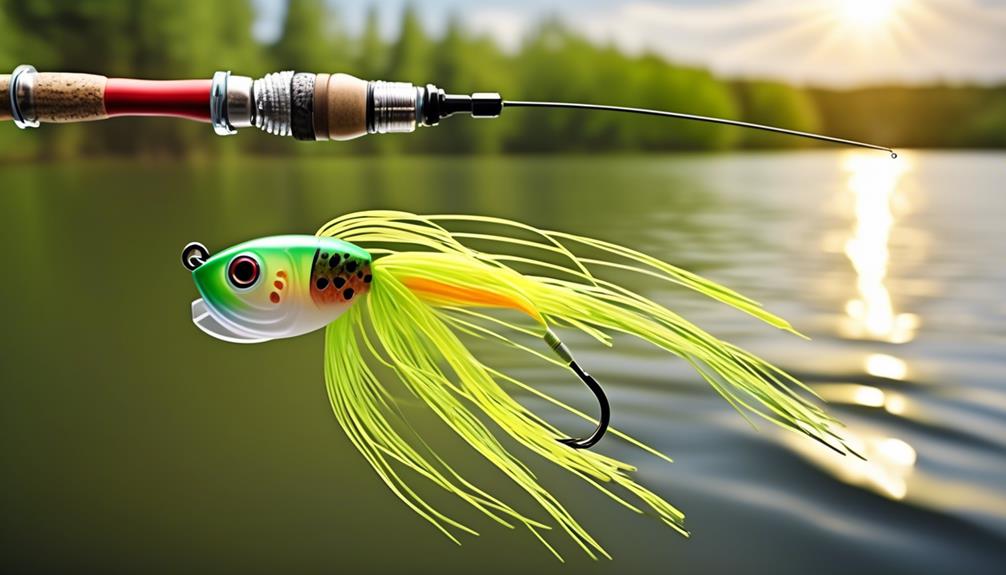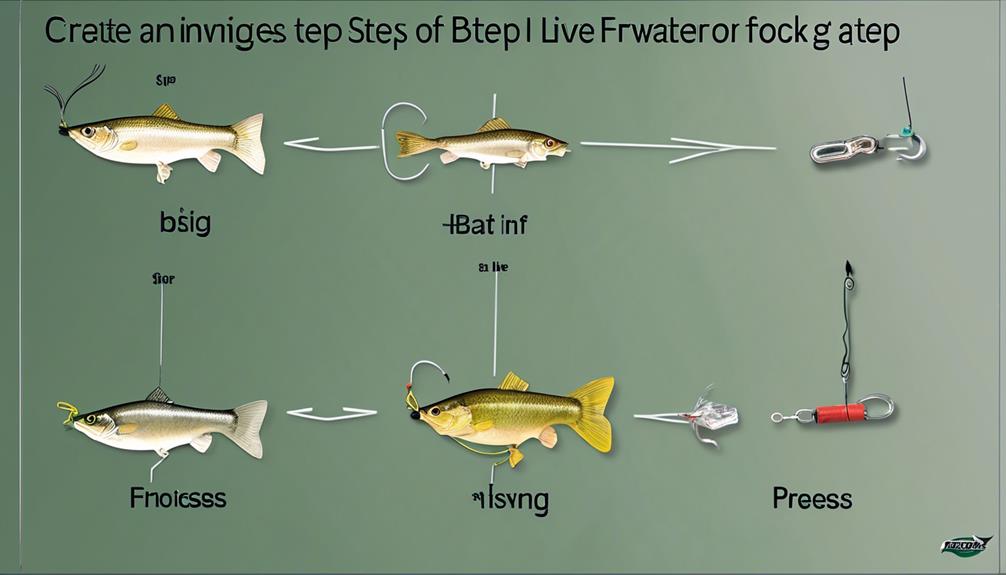You're standing on the shore, casting your line into the clear, still waters, hoping to reel in the catch of the day. But just like a chef carefully selects the best ingredients for a dish, choosing the right bait is crucial for a successful fishing trip.
As you consider the plethora of options available, from live bait to artificial lures, it's important to know which baits will entice the most bites. Whether you're targeting bass, trout, or panfish, the key to a fruitful fishing expedition lies in selecting the best freshwater fishing baits.
But with so many choices, how do you know which ones will truly attract the attention of the elusive underwater inhabitants?
Worms
When freshwater fishing with worms, consider using lively, wriggling bait to attract fish. One effective way to ensure you have access to lively worms is by engaging in worm farming. By cultivating your own supply of worms, you can guarantee that you'll always have a fresh and energetic bait for your fishing trips. To start your worm farming, create a comfortable environment with suitable soil and organic matter for the worms to thrive. Regularly feed and water them, and you'll soon have a sustainable source of bait for your fishing adventures.
In addition to worm farming, bait presentation plays a crucial role in freshwater fishing success. When using worms as bait, it's important to present them in a natural and enticing manner. To achieve this, thread the worm onto the hook carefully, ensuring it remains lively and wriggling. Proper bait presentation mimics the natural movement of live prey, making it more appealing to fish. Remember to adjust the weight of your line and the depth at which you fish based on the behavior of the fish and the water conditions. By paying attention to bait presentation, you can significantly increase your chances of attracting fish and having a successful freshwater fishing experience.
Incorporating lively worms from your worm farm and mastering the art of bait presentation will undoubtedly enhance your freshwater fishing endeavors. So, take the time to perfect these aspects, and get ready to reel in some impressive catches on your next fishing trip.
Minnows
To maximize your freshwater fishing success, consider adding minnows to your bait repertoire, complementing the lively and wriggling appeal of worms with the natural swimming motion of these small fish. When using minnows as bait, it's important to understand their behavior and presentation techniques to attract the attention of your target fish species. Here's what you need to know:
- Natural Swimming Action: Minnows exhibit a natural swimming behavior that entices predatory fish. Their lifelike movement mimics the behavior of small baitfish, making them an irresistible target for larger game fish.
- Depth Variation: Experiment with presenting minnows at different depths to determine where the fish are actively feeding. This can involve using bobbers to keep the minnow at a specific depth or allowing it to swim freely using appropriate weights.
- Live Bait Rigging: Properly rigging a live minnow is crucial for an effective presentation. Techniques such as hooking the minnow through the lips or back allow it to swim freely, increasing its appeal to nearby fish.
- Mimicking Injured Prey: Mimic the behavior of injured baitfish by gently twitching the line to create an erratic swimming pattern. This imitates a distressed minnow, attracting predators seeking an easy meal.
Crickets
You can often enhance your freshwater fishing experience by incorporating crickets as a bait option, leveraging their natural movement and appeal to attract various fish species. When using crickets as bait, it's essential to employ effective strategies to maximize your chances of catching fish.
One effective strategy is to present the cricket bait using a float rig. This allows the cricket to move naturally in the water, mimicking its behavior in its natural habitat and making it more appealing to fish.
Seasonal variations can also impact the effectiveness of using crickets as bait. During the spring and summer months, crickets are abundant and highly active, making them an excellent choice for bait. Fish tend to be more active during these seasons, and the lively movement of crickets can be particularly enticing to them.
In contrast, during the fall and winter, crickets may be less active, and fish may not respond as readily to this type of bait. During these times, it's important to adjust your fishing techniques and consider using alternative baits that are more appealing to fish in colder temperatures.
Incorporating crickets as bait into your freshwater fishing endeavors can be highly effective when using the right strategies and considering seasonal variations. By understanding the natural movements of crickets and how they align with fish behavior throughout the year, you can optimize your fishing experience and increase your chances of a successful catch.
Corn
Incorporate corn as a bait option in your freshwater fishing endeavors, leveraging its versatility and appeal to attract a variety of fish species, especially during seasonal variations in bait effectiveness. Corn can be an effective bait alternative due to its affordability and availability. Here are some corn baiting techniques to enhance your fishing experience:
- Simplicity: Using canned corn straight from the grocery store can be an easy and hassle-free baiting option. Its convenience allows you to focus more on your fishing technique and less on bait preparation.
- Enhanced Attraction: Soaking the corn in attractants such as garlic, strawberry Jell-O, or vanilla extract can significantly increase its appeal to fish. This can help lure in more cautious or less active fish.
- Presentation: Utilize a hair rig or small treble hook to present the corn effectively. This can mimic a natural free-floating bait, making it more enticing to fish.
- Seasonal Adaptation: During colder months, consider using brightly colored corn or adding a touch of glitter to increase visibility in murky waters. In warmer months, natural-colored corn can be more effective as fish are generally more active and less cautious.
Incorporating corn as a bait alternative in your fishing arsenal can be a game-changer. Its versatility, cost-effectiveness, and effectiveness in attracting various fish species make it a valuable addition to your freshwater fishing bait options.
Nightcrawlers
Nightcrawlers are highly effective freshwater fishing baits due to their natural appeal and versatility in attracting a wide range of fish species. These squirmy creatures are known for their behavior of emerging from the ground at night, hence the name 'nightcrawler.' This behavior makes them a prime bait for nocturnal fish such as catfish and walleye. When using nightcrawlers, it's essential to understand their behavior to maximize their effectiveness. They're most active during the night and early morning, so fishing with them during these times can yield the best results.
Proper storage techniques are crucial to keep nightcrawlers lively and attractive to fish. It's important to keep them cool and moist to maintain their freshness. A common method for storing nightcrawlers is to keep them in a container filled with damp soil or peat moss in the refrigerator. This helps to mimic their natural environment and keeps them healthy and active for longer periods. Additionally, ensuring good air circulation in the container is vital to prevent the nightcrawlers from becoming stressed and dying prematurely.
Understanding the behavior of nightcrawlers and implementing proper storage techniques can significantly enhance their effectiveness as bait. By taking care to keep them fresh and utilizing them during their most active times, you can improve your chances of a successful freshwater fishing excursion.
PowerBait
PowerBait is a popular synthetic bait widely used by freshwater anglers to attract fish. This bait comes in various colors and scents, designed to mimic the look and smell of natural bait. Here's why PowerBait is a game-changer for many anglers:
- Easy Application: PowerBait is incredibly easy to use. You simply mold it onto your hook, and you're ready to fish. Unlike live bait, PowerBait stays on the hook well, reducing the hassle of baiting up and the chances of losing your bait.
- Consistent Performance: One of the biggest advantages of PowerBait is its consistency. It remains effective over time, unlike live bait, which can die or lose its appeal to fish after a while.
- Versatility: PowerBait can be shaped and molded into various forms to imitate different types of natural bait, making it versatile and suitable for targeting a wide range of freshwater fish species.
- PowerBait vs. Live Bait Debate: While live bait has its merits, PowerBait offers anglers a reliable, convenient, and long-lasting alternative. It's especially useful for anglers who don't want the hassle of dealing with live bait or those looking for a consistent option for extended fishing trips.
In the PowerBait vs. live bait debate, PowerBait clearly has its advantages, making it a go-to choice for many anglers seeking an effective and hassle-free fishing experience.
Spinnerbaits

Spinnerbaits are versatile lures that can be effective for catching a variety of freshwater fish species. When using spinnerbaits, it's essential to understand the different techniques that can help maximize their effectiveness.
One effective technique is the 'slow-rolling' method, where you retrieve the spinnerbait at a steady pace just above the vegetation. This technique is particularly useful for targeting bass in shallow waters.
Another technique is the 'bulge retrieve,' which involves reeling in the spinnerbait quickly to create a bulging effect on the water's surface, mimicking a fleeing baitfish and enticing aggressive strikes from predatory fish.
In addition to mastering spinnerbait techniques, anglers often make modifications to customize their spinnerbaits for specific fishing conditions. One common modification is changing the blades on the spinnerbait to adjust its vibration and flash.
Colorado blades are known for producing a strong thumping sensation, making them suitable for murky waters, while willow blades create a sleeker profile and work well in clearer conditions.
Another popular modification is adding a trailer hook to increase hook-up ratios, especially when fish are striking short. This simple addition can significantly improve the spinnerbait's effectiveness, particularly when targeting species like pike and muskie.
Jigs
Jigs are versatile fishing lures that come in a variety of shapes, sizes, and colors, making them effective for targeting a wide range of freshwater fish species. When it comes to using jigs for freshwater fishing, there are a few key aspects to consider to maximize your success:
- Jigging techniques: Experiment with different jigging techniques such as hopping, swimming, or dragging the jig along the bottom to mimic the movement of natural prey. Vary your retrieval speed and depth to find the most effective presentation for the fish you're targeting.
- Lure selection: Choose the right jig based on the type of fish you're pursuing and the specific fishing conditions. Heavier jigs are suitable for deeper water or faster current, while lighter jigs work well in shallower areas or slower water.
- Seasonal jigging patterns: Pay attention to seasonal patterns in fish behavior and adjust your jigging approach accordingly. In the warmer months, fish may be more active and willing to chase fast-moving jigs, while in colder months, a slower, more methodical presentation might be necessary.
- Color choices: The color of your jig can make a significant difference in attracting fish. In murky water, bright or contrasting colors can help fish locate your jig, while in clear water, more natural hues may be preferred.
Frequently Asked Questions
What Are the Best Types of Freshwater Fish to Target With Each Bait Option?
To catch the best freshwater fish, use bait recommendations based on the types of bait and the freshwater environments you're fishing in. Each bait option is suited for specific freshwater fish, maximizing your chances of success.
How Should I Properly Store and Maintain Live Bait for Freshwater Fishing?
To properly store and maintain live bait for freshwater fishing, keep it in a cool, aerated container with damp bedding. Change the water regularly and avoid overcrowding. When using the bait, adjust techniques based on the environment for optimal results.
Are There Any Specific Techniques or Tips for Using Each Bait Option Effectively in Different Freshwater Environments?
When fishing in freshwater, techniques and tips for using different baits effectively depend on the specific environments you're in. Understanding the behavior of the fish and adjusting your approach accordingly can greatly improve your effectiveness.
Can You Provide Recommendations for the Best Times of Day or Seasons to Use Each Type of Bait for Freshwater Fishing?
For the best times of day and optimal seasons to use each type of bait for freshwater fishing, consider the fishing techniques and location tips. Expert recommendations can help you maximize your catch.
Are There Any Specific Regulations or Restrictions on Using Certain Types of Bait in Different Freshwater Fishing Locations?
In different freshwater fishing locations, regulations and restrictions on bait usage vary. Make sure to check local rules before choosing your bait. Proper bait storage and live bait maintenance are essential to comply with these regulations.
Conclusion
So next time you're heading out for some freshwater fishing, make sure to pack your tackle box with these expert-recommended baits.
Whether it's worms, minnows, crickets, or any of the other options listed, you'll be sure to have a successful fishing trip.
Happy fishing!



